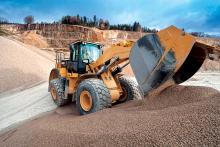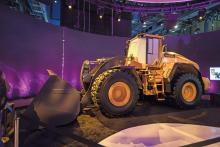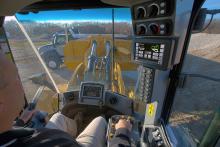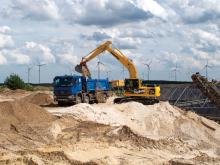
There are more manufacturers competing in the wheeled loader sector than in almost any other area of the plant market. Dan Gilkes looks at some of the options available.
The wheeled loading shovel remains one of the mainstays of almost every quarry operation around the world. From the smallest family-run business to the largest multi-national, wheeled loaders can work as prime movers, digging at the blasted face, or as rehandling machines operating in a stocking and loading area.
There is a saying among some quarry companies that no-one ever got sacked for buying a
Of course machine size is relative, Cat and Komatsu have few competitors when it comes to the giants of loader work such as Caterpillar’s 195tonne 944H, with its 14-36m3 bucket capacities, or Komatsu’s similarly massive WA1200-6, that tips the scales at 220tonnes.
There are plenty of manufacturers snapping at their heels at the lighter end however, with the likes of
Powered by a Tier 2
The machine is typical of many in this size range, delivering strong engine performance with a range of operating modes, to allow the customer to match the machine to the application. Indeed what has for many years been a relatively simple machine is becoming increasingly sophisticated as electronics play a greater role in wheeled loader control.
A number of manufacturers, including Doosan,
The transmission doesn’t just provide good travel performance however, as through an intelligent clutch cut-off system the operator is able to disconnect the transmission from the engine by operating the brake pedal, allowing 100% of engine output to be channelled to the loader arms for maximum breakout and lifting forces.
Volvo has developed its own system of transmission disconnect, to make directional changes smoother and reduce fuel consumption in load and haul duties.
The Optishift transmission reduces losses within the torque converter by locking the stator in second, third and fourth gears, to improve efficiency. Reverse By Braking automatically uses the machine’s service brakes to slow the loader when the operator moves from forward to reverse gears or back again, even if they haven’t applied the brake pedal themselves. Rather than the torque converter taking the strain of the change in direction, the brakes provide the required deceleration, reducing fuel consumption and stress on the transmission.
These aren’t the only driveline developments at present though, as both machine manufacturers and component companies are looking for ways to increase operating efficiency.
Liebherr has long maintained that a hydrostatic transmission system offers fuel savings of up to 25% compared to a mechanical powershift transmission in a repetitive wheeled loading application. However the hydrostatic driveline can have its limitations, particularly in longer load and carry operations.
One possible solution might be what has become known as the hydraulically variable transmission (HVT). Caterpillar is offering this solution on its 966K XE, which uses a hydraulic pump and motor to provide a constantly variable gear ratio, in combination with a parallel mechanical gear transmission.
The power from the two systems is combined through a series of planetary gears, to maximise transmission efficiency. To the operator this all works automatically, although they can set virtual gear ratios to limit the speed of operation. Cat claims the XE system can deliver fuel efficiency gains of up to 25% compared to a standard 966K.
Both Dana Rexroth and ZF will launch similar transmission systems at the bauma exhibition this year in Munich, offering wheeled loader manufacturers that don’t produce their own components an additional transmission option for some of their mid-size machines.
Komatsu will introduce two new Dash 7 wheeled loaders at the same exhibition. The WA380-7 and WA500-7 weigh in at 18 and 33tonnes respectively. Both machines use a revised large capacity torque converter with a lock-up facility that works in second to fourth gears. This is said to improve hill climbing ability and acceleration, while reducing fuel consumption.
Operator cab comfort has also been a major focus of design for wheeled loader manufacturers of late. Customers have realised that a relaxed, comfortable operator is more productive through a working shift, and that things like suspension seats and air conditioning are not luxuries, but necessities.
Doosan’s latest DL250A, DL300A and DL420A have been specifically designed for the African and Middle East markets. The smaller machine is powered by a Tier 1 Doosan engine while the larger two machines have moved to Tier 2 emissions standards.
However operators will appreciate the changes to the cab on these machines, as it is 6% larger on the DL250A and 11% more spacious on the other two models. The air conditioning system in the cab has a 30% increase in nozzle size, improving cooling, while he cab also benefits from a new instrument panel, improved storage and upgraded switchgear.
XGMA is one of a growing number of Chinese wheeled loader manufacturers looking to market machines outside the domestic market. The Chinese wheeled loader sector remains the single biggest loader market in the world, but companies are hoping to build through export as well.
XGMA’s XG935H was just one of a large range of machines introduced at last year’s bauma China event. One of the biggest on show was LiuGong’s 890, the firm’s biggest wheeled loader with a 7m3 bucket capacity and a 422hp (315kW) engine.
Shantui also took the opportunity to unveil a new large machine, the SL80W. Weighing in at 29tonnes, the machine uses a 4.5m3 bucket and comes with a Weicha Steyr diesel engine. Though mainly aimed at the domestic market, Cheng Gong also launched a 966H loader at the show, fitting into the firm’s range at the 6tonne mark. As mentioned, the wheeled loader sector is one of the busiest market areas in the construction equipment business, with numerous manufacturers keen to capture sales. This diverse range of companies provides customers with varying levels of technology, and a correspondingly broad price entry point.











